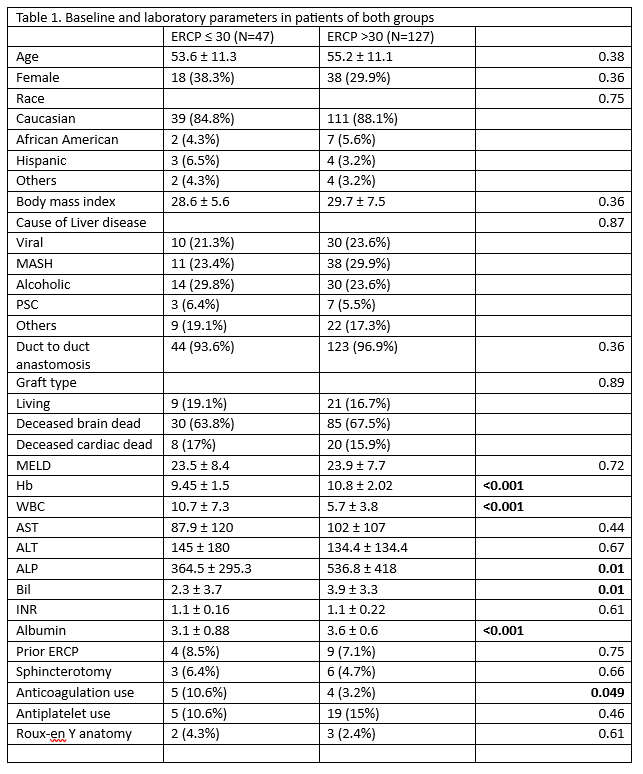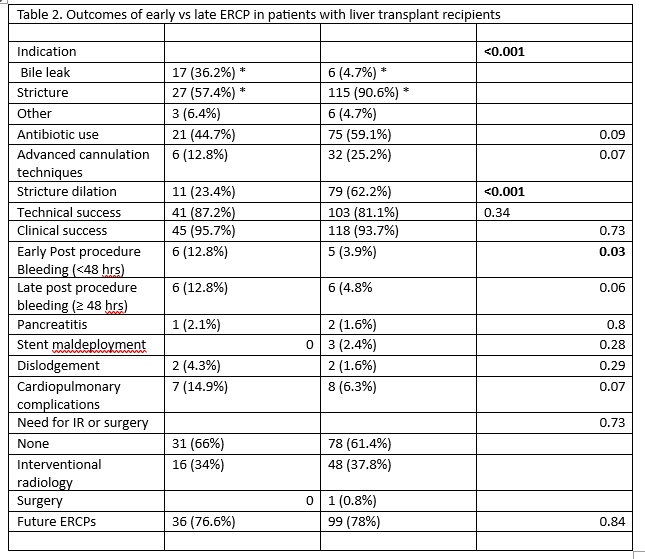Back to 2024 Abstracts
SAFETY AND OUTCOMES OF EARLY VS LATE ERCP IN LIVER TRANSPLANT RECIPIENTS
Rajat Garg
*, Anthony Gallo, Khaled Alsabbagh Alchirazi, Amandeep Singh, Sunguk Jang, Prabhleen Chahal
Cleveland Clinic, Cleveland, OH
IntroductionBiliary complications remain a common source of morbidity following liver transplantation (LT). The most common post-transplant biliary complications are strictures and leaks. Endoscopic retrograde cholangio-pancreatography (ERCP) has become first line of therapy for post-transplant biliary complications. However, outcomes of ERCP in early as compared to late LT period is not known. We aimed to study the safety and outcomes of late (>30) vs early (≤30 days) ERCP in LT recipients with biliary complications.
MethodsAfter IRB approval, we conducted a retrospective analysis patient who underwent ERCP after LT at Cleveland Clinic. Variable such as baseline, transplant indication, MELD score at the time of transplant, baseline labs prior to ERCP, procedure factors such as antibiotic use, prior medication use, and post procedure outcomes were collected. The patients were then divided into 2 groups: ERCP ≤ 30 ERCP > 30 days after liver transplant. The outcomes were technical success, clinical success and adverse events post ERCP.
ResultsA total of 174 from 2012 – 2021 were included in our analysis. Mean age, gender, race, BMI, etiology of liver disease, type of liver graft and type of anastomosis were similar in both groups (Table 1). Patient who had ERCP in ≤ 30 days had significantly lower hemoglobin, alkaline phosphatase, bilirubin and albumin and higher white cell count as compared to patient who underwent ERCP after 30 days post-transplant (Table 1). Patient who had ERCP ≤ 30 days had more patients on anticoagulation (10.6% vs. 3.2%, p=0.049) with no difference in antiplatelet drugs (Table 1). ERCP ≤ 30 days was performed more commonly for indication of bile leak (36.2% vs. 4.7%) whereas ERCP > 30 days was performed for biliary stricture (90.6% vs. 57.4%) (P < 0.001). Patient who underwent ERCP ≤ 30 days at significantly high rates of post procedure bleeding (12.8% versus 3.9%, p=0.03). In terms of procedural details, there were no significant differences in patient with prior ERCP and sphincterotomy done, history of Roux-en-Y anatomy, antibiotic uses during the procedure, advance cannulation technique but there were significantly high rates of balloon dilation in patients who underwent >30 days liver transplant. Technical success, late postprocedural bleeding, post ERCP pancreatitis, stent deployment, dislodgment and cardiopulmonary complications were similar in both groups (Table 2). Similarly, need for future ERCP, interventional radiology or surgical interventions were also similar in both groups (Table 2).
ConclusionIn this study, we report high rates of early post-procedure bleeding in patients who underwent ERCP ≤ 30 days of liver transplant as compared to ERCP > 30 days with overall similar rates of technical and clinical success. This data will help risk stratify patient prior to ERCP post liver transplant.


Back to 2024 Abstracts

